trailer Peugeot 3008 Hybrid 4 2017 Owner's Guide
[x] Cancel search | Manufacturer: PEUGEOT, Model Year: 2017, Model line: 3008 Hybrid 4, Model: Peugeot 3008 Hybrid 4 2017Pages: 566, PDF Size: 16.05 MB
Page 341 of 566
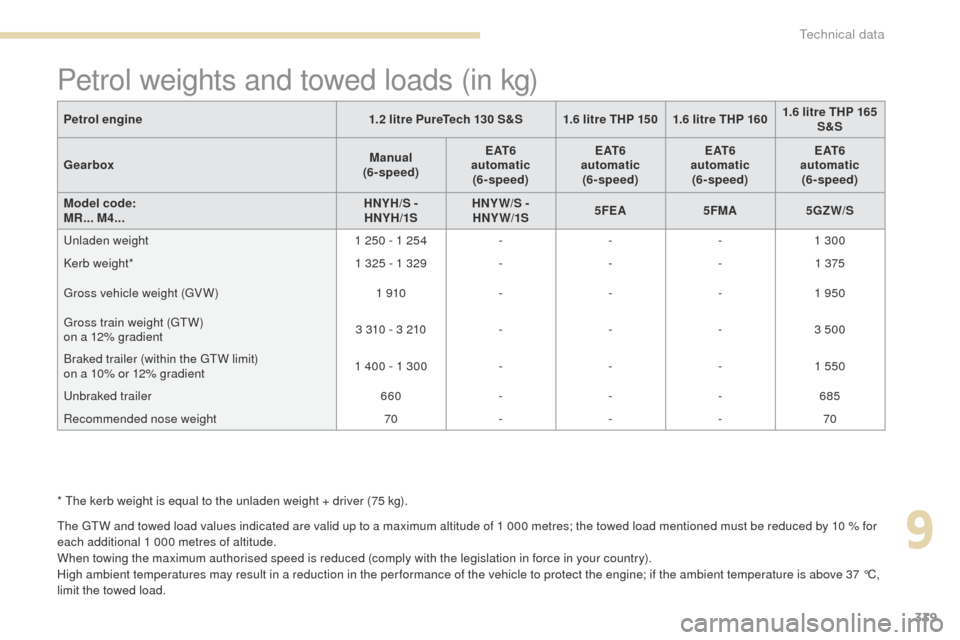
339
3008-2_en_Chap09_caracteristiques_ed01-2016
Petrol weights and towed loads (in kg)
The GTW and towed load values indicated are valid up to a maximum altitude of 1 000 metres; the towed load mentioned must be reduced by 10 % for
each additional 1 000 metres of altitude.
When towing the maximum authorised speed is reduced (comply with the legislation in force in your country).
High ambient temperatures may result in a reduction in the per formance of the vehicle to protect the engine; if the ambient temperature is above 37 °C,
limit the towed load.Petrol engine
1.2 litre PureTech 130 S&S 1.6 litre THP 150 1.6 litre THP 160 1.6 litre THP 165
S&S
Gearbox Manual
(6- speed) E AT 6
automatic (6- speed) E AT 6
automatic (6- speed) E AT 6
automatic (6- speed) E AT 6
automatic (6- speed)
Model code:
MR... M4... HNYH/S -
HNYH/1S HNY W/S -
HNY W/1S 5FEA
5FMA5GZW/S
Unladen weight 1 250 - 1 254---1 300
Kerb weight* 1 325 - 1 329---1 375
Gross vehicle weight (GV W) 1 910---1 950
Gross train weight (GTW)
on a 12% gradient 3 310 - 3 210
---3 500
Braked trailer (within the GTW limit)
on a 10% or 12% gradient 1 400 - 1 300
---1 550
Unbraked trailer 660---685
Recommended nose weight 70---70
* The kerb weight is equal to the unladen weight + driver (75 kg).
9
Technical data
Page 344 of 566
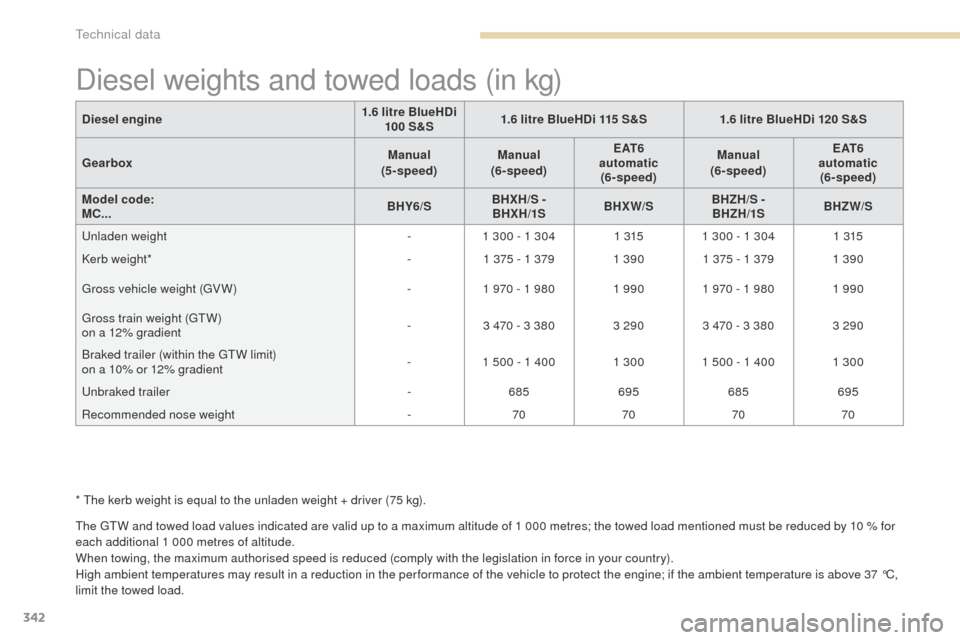
342
3008-2_en_Chap09_caracteristiques_ed01-2016
Diesel weights and towed loads (in kg)
The GTW and towed load values indicated are valid up to a maximum altitude of 1 000 metres; the towed load mentioned must be reduced by 10 % for
each additional 1 000 metres of altitude.
When towing, the maximum authorised speed is reduced (comply with the legislation in force in your country).
High ambient temperatures may result in a reduction in the per formance of the vehicle to protect the engine; if the ambient temperature is above 37 °C,
limit the towed load.Diesel engine
1.6 litre BlueHDi
100 S&S 1.6 litre BlueHDi 115 S&S
1.6 litre BlueHDi 120 S&S
Gearbox Manual
(5 -speed ) Manual
(6- speed) E AT 6
automatic (6- speed) Manual
(6- speed) E AT 6
automatic (6- speed)
Model code:
MC... BHY6/SBHXH/S -
BHXH/1S BHXW/SBHZH/S -
BHZH/1S BHZW/S
Unladen weight -1 300 - 1 304 1 3151 300 - 1 304 1 315
Kerb weight* -1 375 - 1 379 1 390 1 375 - 1 379 1 390
Gross vehicle weight (GV W) -1 970 - 1 980 1 990 1 970 - 1 980 1 990
Gross train weight (GTW)
on a 12% gradient -
3 470 - 3 380 3 290 3 470 - 3 380 3 290
Braked trailer (within the GTW limit)
on a 10% or 12% gradient -
1 500 - 1 400 1 300 1 500 - 1 400 1 300
Unbraked trailer -685 695685695
Recommended nose weight -70 707070
* The kerb weight is equal to the unladen weight + driver (75 kg).
Technical data
Page 345 of 566
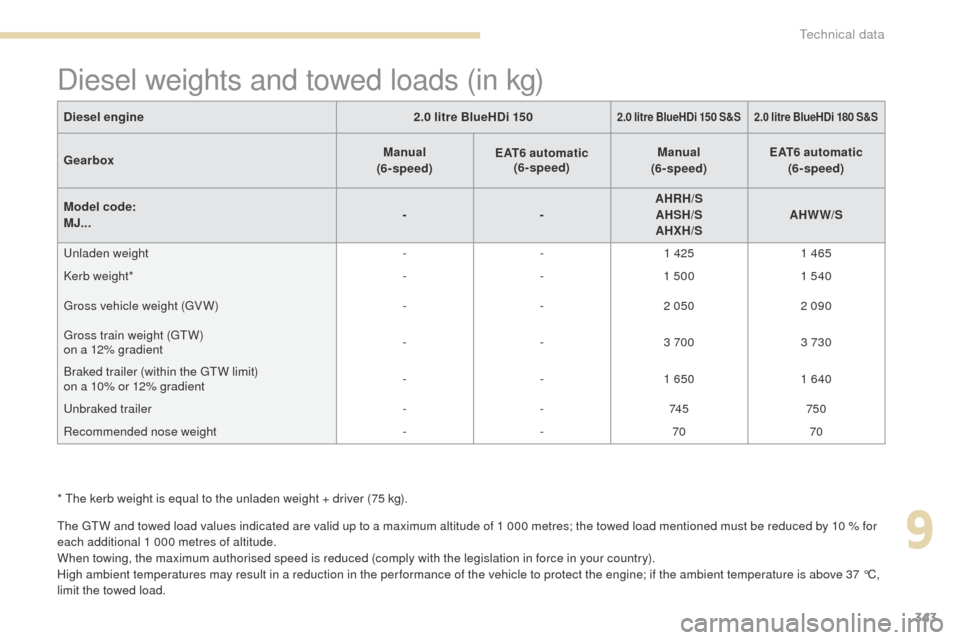
343
3008-2_en_Chap09_caracteristiques_ed01-2016
The GTW and towed load values indicated are valid up to a maximum altitude of 1 000 metres; the towed load mentioned must be reduced by 10 % for
each additional 1 000 metres of altitude.
When towing, the maximum authorised speed is reduced (comply with the legislation in force in your country).
High ambient temperatures may result in a reduction in the per formance of the vehicle to protect the engine; if the ambient temperature is above 37 °C,
limit the towed load.Diesel engine
2.0 litre BlueHDi 150
2.0 litre BlueHDi 150 S&S 2.0 litre BlueHDi 180 S&S
GearboxManual
(6- speed) EAT6 automatic
(6- speed) Manual
(6- speed) EAT6 automatic
(6- speed)
Model code:
MJ... -
-AHRH/S
AHSH/S
AHXH/S AHWW/S
Unladen weight --1 425 1 465
Kerb weight* --1 500 1 540
Gross vehicle weight (GV W) --2 050 2 090
Gross train weight (GTW)
on a 12% gradient -
-3 700 3 730
Braked trailer (within the GTW limit)
on a 10% or 12% gradient -
-1 650 1 640
Unbraked trailer --74 5 750
Recommended nose weight --70 70
* The kerb weight is equal to the unladen weight + driver (75 kg).
Diesel weights and towed loads (in kg)
9
Technical data
Page 347 of 566
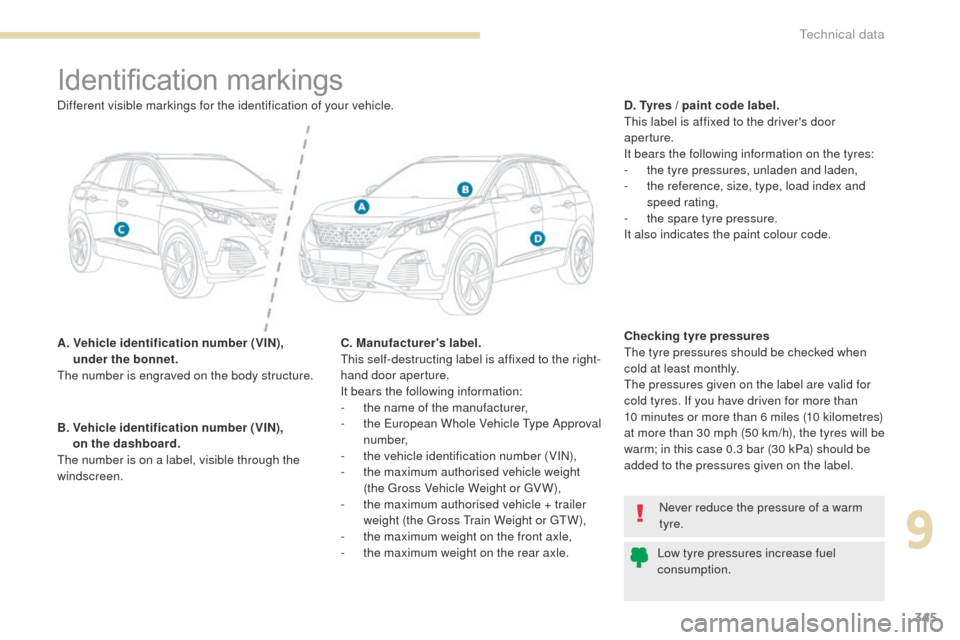
345
3008-2_en_Chap09_caracteristiques_ed01-2016
Identification markings
A. Vehicle identification number (VIN), under the bonnet.
The number is engraved on the body structure. D. Tyres / paint code label.
This label is affixed to the driver's door
aperture.
It bears the following information on the tyres:
-
t
he tyre pressures, unladen and laden,
-
t
he reference, size, type, load index and
speed rating,
-
t
he spare tyre pressure.
It also indicates the paint colour code.
B.
V
ehicle identification number (VIN),
on the dashboard.
The number is on a label, visible through the
windscreen.
Never reduce the pressure of a warm
tyre.
Low tyre pressures increase fuel
consumption.
Different visible markings for the identification of your vehicle.
Checking tyre pressures
The tyre pressures should be checked when
cold at least monthly.
The pressures given on the label are valid for
cold tyres. If you have driven for more than
10 minutes or more than 6 miles (10 kilometres)
at more than 30 mph (50 km/h), the tyres will be
warm; in this case 0.3 bar (30 kPa) should be
added to the pressures given on the label.
C. Manufacturer's label.
This self-destructing label is affixed to the right-
hand door aperture.
It bears the following information:
-
t
he name of the manufacturer,
-
t
he European Whole Vehicle Type Approval
number,
-
t
he vehicle identification number (VIN),
-
t
he maximum authorised vehicle weight
(the Gross Vehicle Weight or GV W),
-
t
he maximum authorised vehicle + trailer
weight (the Gross Train Weight or GTW),
-
t
he maximum weight on the front axle,
-
t
he maximum weight on the rear axle.
9
Technical data
Page 353 of 566
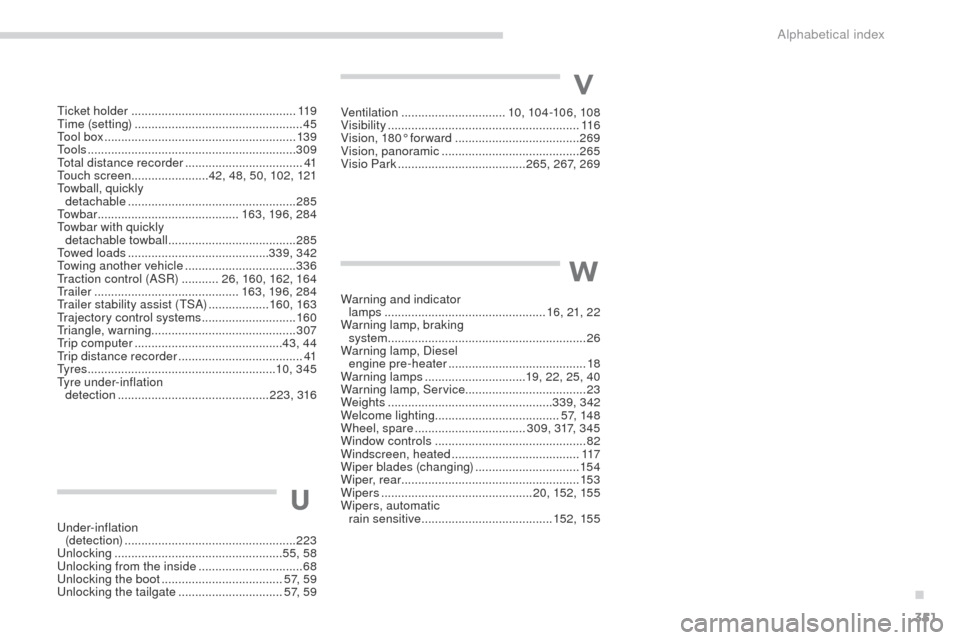
351
3008-2_en_Chap11_index-alpha_ed01-2016
U
Under-inflation (detection) ................................................... 223
Unlocking
..............................
....................55, 58
Unlocking from the inside
...............................68
U
nlocking the boot .................................... 57, 59
Unlocking the tailgate
...............................57, 59
Ticket holder
.................................................
11
9
Time (setting)
..............................
....................
45
Tool box
.........................................................
13 9
To o l s
..............................................................
309
Total distance recorder
...................................
41
Touch screen ....................... 42, 48 , 50, 102 , 121
Towball, quickly detachable
..................................................
285
To w b a r
..........................................
163, 19 6 , 284
Towbar with quickly detachable towball
...................................... 28
5
Towed loads
..........................................
339, 342
Towing another vehicle
................................. 33
6
Traction control (ASR)
...........
26, 160 , 162, 16 4
Tr a i l e r
...........................................
163, 19 6 , 284
Trailer stability assist (TSA)
..................
160, 163
Trajectory control systems ............................
160
Triangle, warning ........................................... 307
Trip computer
............................................
43, 44
Trip distance recorder
.....................................
41
Ty r e s
........................................................
10, 345
Tyre under-inflation detection
.............................................
223, 316
V
Ventilation .............................. .10 , 104 -10 6 , 108
Visibility ......................................................... 11 6
Vision, 180° for ward
..................................... 26
9
Vision, panoramic
......................................... 265
Visio Park
...................................... 265, 267 , 269
W
Warning and indicator
lamps .............................. ..................16, 21 , 22
Warning lamp, braking system
........................................................... 26
Warning lamp, Diesel engine pre-heater
...............................
..........18
Warning lamps
.............................. 19, 22 , 25, 40
Warning lamp, Service ....................................23
Weights
................................................. 339, 342
Welcome lighting ..................................... 57, 148
Wheel, spare
................................. 309, 317 , 345
Window controls
............................................. 82
Windscreen, heated
...................................... 117
Wiper blades (changing)
............................... 15
4
Wiper, rear ..................................................... 153
Wipers
............................................. 20, 152 , 155
Wipers, automatic rain sensitive
....................................... 15
2, 155
.
Alphabetical index
Page 545 of 566
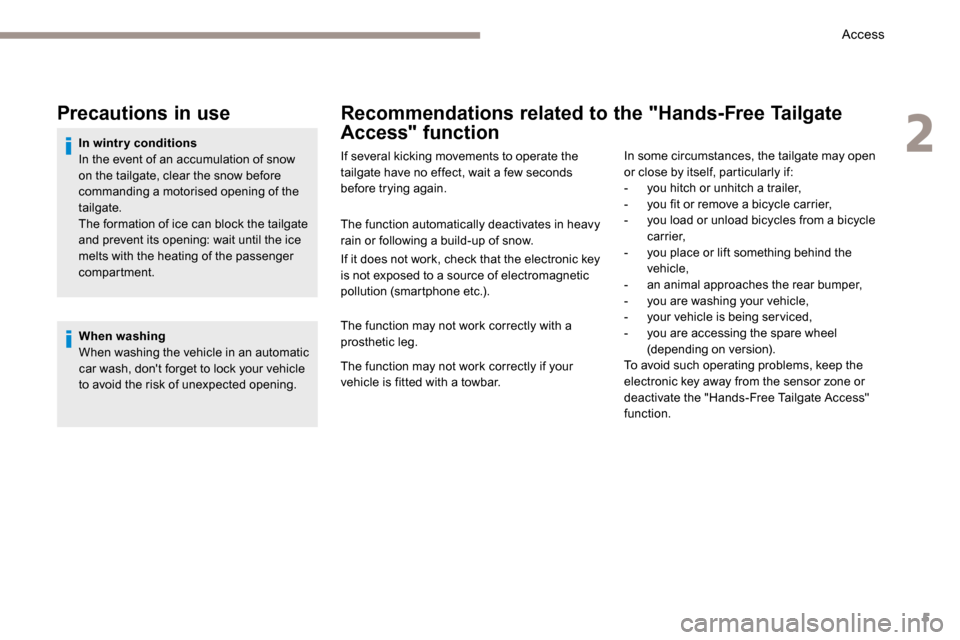
5
Precautions in use
In wintry conditions
In the event of an accumulation of snow
on the tailgate, clear the snow before
commanding a motorised opening of the
tailgate.
The formation of ice can block the tailgate
and prevent its opening: wait until the ice
melts with the heating of the passenger
compartment.When washing
When washing the vehicle in an automatic
car wash, don't forget to lock your vehicle
to avoid the risk of unexpected opening.
Recommendations related to the "Hands-Free Tailgate
Access" function
If several kicking movements to operate the
tailgate have no effect, wait a few seconds
before trying again.
The function automatically deactivates in heavy
rain or following a build-up of snow.
If it does not work, check that the electronic key
is not exposed to a source of electromagnetic
pollution (smartphone etc.).
The function may not work correctly with a
prosthetic leg.
The function may not work correctly if your
vehicle is fitted with a towbar. In some circumstances, the tailgate may open
or close by itself, particularly if:
-
you hitch or unhitch a trailer,
- you fit or remove a bicycle carrier,
- you load or unload bicycles from a bicycle
c a r r i e r,
- you place or lift something behind the
vehicle,
- an animal approaches the rear bumper,
- you are washing your vehicle,
- your vehicle is being serviced,
- you are accessing the spare wheel
(depending on version).
To avoid such operating problems, keep the
electronic key away from the sensor zone or
deactivate the "Hands-Free Tailgate Access"
function.
2
Access
Page 553 of 566
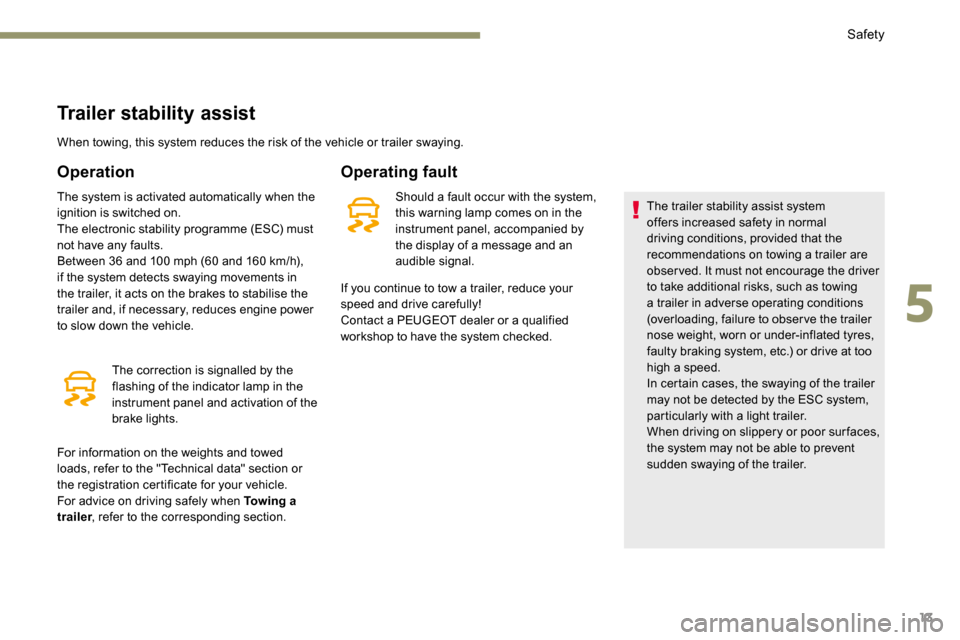
13
Trailer stability assist
When towing, this system reduces the risk of the vehicle or trailer swaying.
Operation
The system is activated automatically when the
ignition is switched on.
The electronic stability programme (ESC) must
not have any faults.
Between 36 and 100 mph (60 and 160 km/h),
if the system detects swaying movements in
the trailer, it acts on the brakes to stabilise the
trailer and, if necessary, reduces engine power
to slow down the vehicle.The correction is signalled by the
flashing of the indicator lamp in the
instrument panel and activation of the
brake lights.
Operating fault
Should a fault occur with the system,
this warning lamp comes on in the
instrument panel, accompanied by
the display of a message and an
audible signal. The trailer stability assist system
offers increased safety in normal
driving conditions, provided that the
recommendations on towing a trailer are
obser ved. It must not encourage the driver
to take additional risks, such as towing
a trailer in adverse operating conditions
(overloading, failure to obser ve the trailer
nose weight, worn or under-inflated tyres,
faulty braking system, etc.) or drive at too
high a speed.
In certain cases, the swaying of the trailer
may not be detected by the ESC system,
particularly with a light trailer.
When driving on slippery or poor sur faces,
the system may not be able to prevent
sudden swaying of the trailer.
If you continue to tow a trailer, reduce your
speed and drive carefully!
Contact a PEUGEOT dealer or a qualified
workshop to have the system checked.
For information on the weights and towed
loads, refer to the "Technical data" section or
the registration certificate for your vehicle.
For advice on driving safely when Towing a
trailer , refer to the corresponding section.
5
Safety
Page 555 of 566
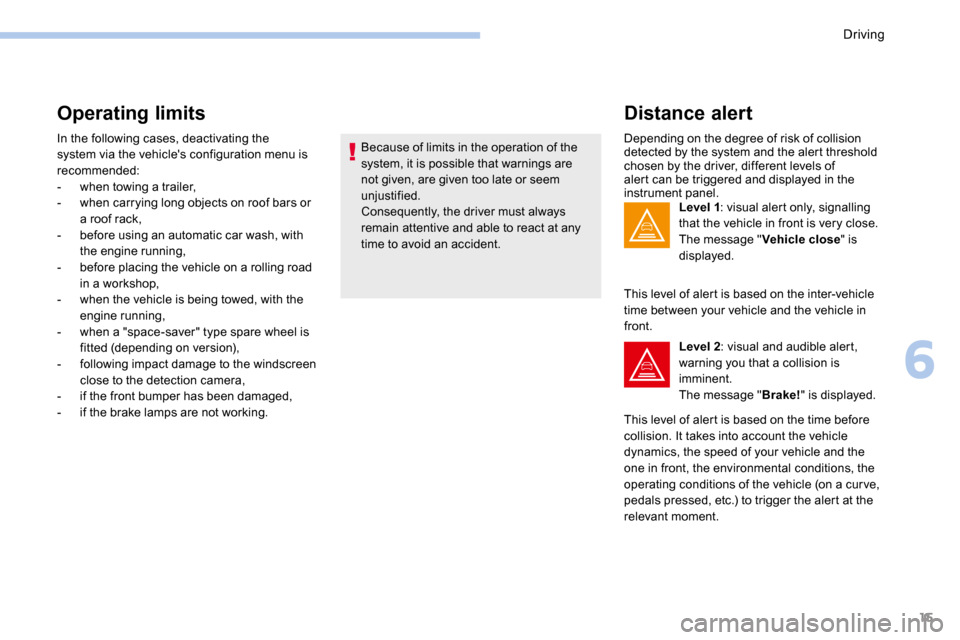
15
Operating limits
In the following cases, deactivating the
system via the vehicle's configuration menu is
recommended:
- when towing a trailer,
- when carrying long objects on roof bars or
a roof rack,
- before using an automatic car wash, with
the engine running,
- before placing the vehicle on a rolling road
in a workshop,
- when the vehicle is being towed, with the
engine running,
- when a "space-saver" type spare wheel is
fitted (depending on version),
- following impact damage to the windscreen
close to the detection camera,
- if the front bumper has been damaged,
- if the brake lamps are not working. Because of limits in the operation of the
system, it is possible that warnings are
not given, are given too late or seem
unjustified.
Consequently, the driver must always
remain attentive and able to react at any
time to avoid an accident.
Distance alert
Depending on the degree of risk of collision
detected by the system and the alert threshold
chosen by the driver, different levels of
alert can be triggered and displayed in the
instrument panel.
Level 1: visual alert only, signalling
that the vehicle in front is very close.
The message " Vehicle close" is
displayed.
This level of alert is based on the inter-vehicle
time between your vehicle and the vehicle in
front. Level 2: visual and audible alert,
warning you that a collision is
imminent.
The message " Brake!" is displayed.
This level of alert is based on the time before
collision. It takes into account the vehicle
dynamics, the speed of your vehicle and the
one in front, the environmental conditions, the
operating conditions of the vehicle (on a cur ve,
pedals pressed, etc.) to trigger the alert at the
relevant moment.
6
Driving
Page 559 of 566
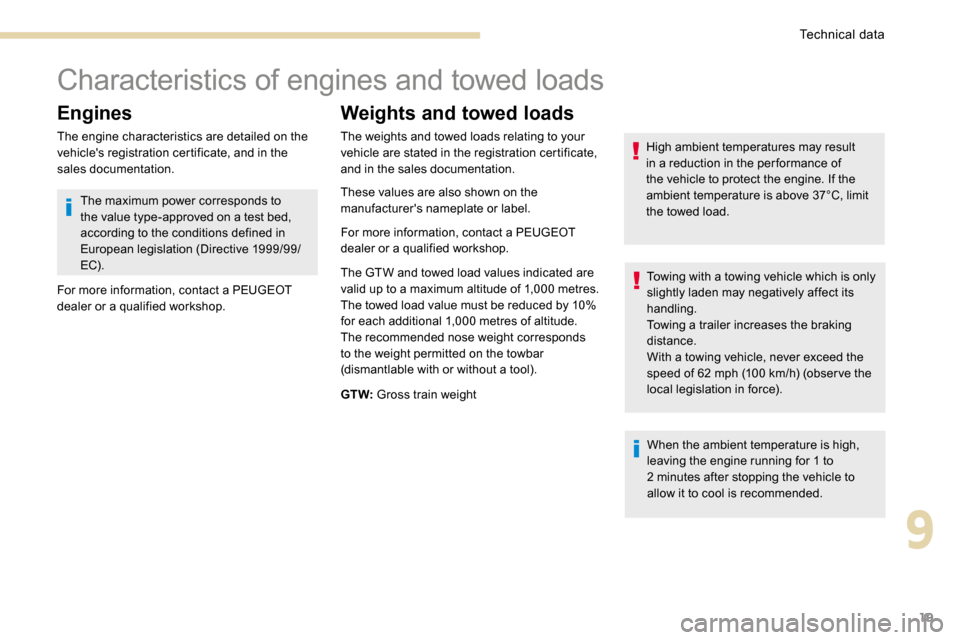
19
Characteristics of engines and towed loads
Engines
The engine characteristics are detailed on the
vehicle's registration certificate, and in the
sales documentation.
Weights and towed loads
When the ambient temperature is high,
leaving the engine running for 1 to
2 minutes after stopping the vehicle to
allow it to cool is recommended.
The weights and towed loads relating to your
vehicle are stated in the registration certificate,
and in the sales documentation.
These values are also shown on the
manufacturer's nameplate or label.
For more information, contact a PEUGEOT
dealer or a qualified workshop.
The GTW and towed load values indicated are
valid up to a maximum altitude of 1,000 metres.
The towed load value must be reduced by 10%
for each additional 1,000 metres of altitude.
The recommended nose weight corresponds
to the weight permitted on the towbar
(dismantlable with or without a tool).
GT W:
Gross train weight High ambient temperatures may result
in a reduction in the per formance of
the vehicle to protect the engine. If the
ambient temperature is above 37°C, limit
the towed load.
Towing with a towing vehicle which is only
slightly laden may negatively affect its
handling.
Towing a trailer increases the braking
distance.
With a towing vehicle, never exceed the
speed of 62 mph (100 km/h) (obser ve the
local legislation in force).
The maximum power corresponds to
the value type-approved on a test bed,
according to the conditions defined in
European legislation (Directive 1999/99/
EC).
For more information, contact a PEUGEOT
dealer or a qualified workshop.
9
Technical data
Page 560 of 566
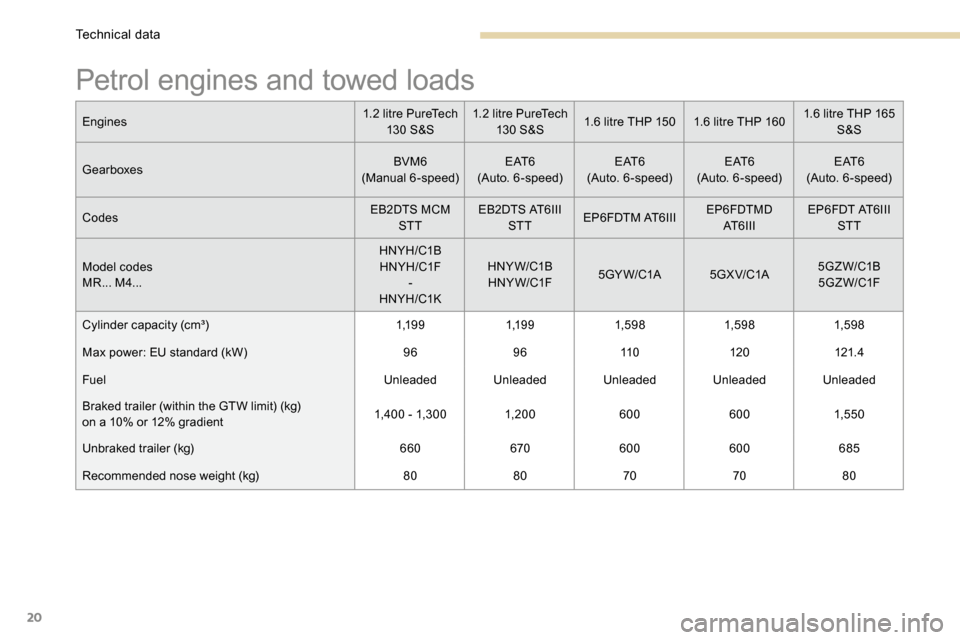
20
Petrol engines and towed loads
Engines1.2 litre PureTech
13 0 S &S 1.2 litre PureTech
13 0 S &S 1.6 litre THP 150
1.6 litre THP 160 1.6 litre THP 165
S&S
Gearboxes BVM6
(Manual 6-speed) E AT 6
(Auto. 6-speed) E AT 6
(Auto. 6-speed) E AT 6
(Auto. 6-speed) E AT 6
(Auto. 6-speed)
Codes EB2DTS MCM
STT EB2DTS AT6III
STT EP6FDTM AT6III EP6FDTMD
AT6III EP6FDT AT6III
STT
Model codes
MR... M4... HNYH/C1B
HNYH/C1F -
HNYH/C1K HNYW/C1B
HNYW/C1F 5GY W/C1A
5GX V/C1A5GZ W/C1B
5G Z W/C1F
Cylinder capacity (cm³) 1,1 9 91,1 9 91,59 8 1,59 81,59 8
Max power: EU standard (kW) 969611 0 120121.4
Fuel UnleadedUnleadedUnleadedUnleadedUnleaded
Braked trailer (within the GTW limit) (kg)
on a 10% or 12% gradient 1,4 0 0 - 1,3 0 0
1, 20 06006001,550
Unbraked trailer (kg) 660670600 600 685
Recommended nose weight (kg) 8080 707080
Technical data